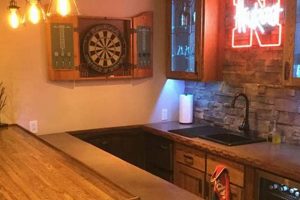The concept involves constructing a freestanding structure in an outdoor space, providing shelter and serving as a focal point for relaxation or entertainment. These structures, often roofed and open-sided, offer protection from the elements and enhance the usability of the outdoor area. A practical example includes a homeowner erecting a wooden structure with a solid roof to create a dining and lounging area away from the main residence.
The construction of such a structure significantly increases the value and enjoyment of residential property. It provides a dedicated outdoor space for gatherings, relaxation, and dining. Historically, similar constructions have served as central gathering points, demonstrating the enduring human need for sheltered outdoor spaces. Benefits include increased property value, enhanced outdoor living experience, and provision of a functional and aesthetically pleasing feature for the backyard.
The following sections will delve into various design considerations, material choices, step-by-step construction processes, and cost-effective strategies for creating personalized and functional outdoor shelters. Focus will be given to achieving a balance between structural integrity, aesthetic appeal, and budget constraints.
Essential Considerations for Outdoor Structure Construction
The successful creation of an outdoor shelter necessitates careful planning and execution. The following points offer guidance to ensure structural integrity, aesthetic appeal, and long-term usability.
Tip 1: Site Assessment and Planning: Thoroughly evaluate the intended location, considering sun exposure, drainage, wind patterns, and proximity to utilities. Develop a detailed plan that accounts for dimensions, materials, and desired functionalities.
Tip 2: Foundation Integrity: A stable foundation is paramount. Depending on the size and design, consider concrete footings, a gravel base, or a poured concrete slab. Ensure proper leveling and adherence to local building codes.
Tip 3: Material Selection: Choose materials based on durability, weather resistance, and aesthetic compatibility with the surrounding environment. Pressure-treated lumber, cedar, and composite materials are common choices for framing and decking.
Tip 4: Structural Design and Load Bearing: Adhere to sound structural engineering principles. Ensure adequate post spacing, beam sizing, and rafter design to support anticipated loads, including snow and wind.
Tip 5: Roofing Considerations: Select roofing materials that provide adequate weather protection and complement the overall design. Asphalt shingles, metal roofing, and wooden shakes are viable options. Ensure proper slope for water runoff.
Tip 6: Ventilation and Airflow: Incorporate design elements that promote natural ventilation. Adequate airflow minimizes moisture buildup and enhances comfort during warmer months. Open sides or strategic placement of vents can achieve this.
Tip 7: Compliance with Building Codes: Prior to commencing construction, research and adhere to all applicable local building codes and regulations. Obtain necessary permits to avoid potential legal issues.
Tip 8: Professional Consultation: For complex designs or if lacking experience, consult with a qualified structural engineer or contractor. Professional guidance can ensure safety, code compliance, and project success.
Adhering to these considerations promotes the creation of an outdoor structure that enhances property value, provides functional space, and withstands the rigors of outdoor exposure.
The subsequent sections will explore specific design styles, customizable features, and landscaping integration strategies to further optimize outdoor shelter projects.
1. Design
Design is a critical determinant in the successful execution of “diy backyard pavilion ideas.” The initial design phase dictates the structural form, material selection, and overall aesthetic, thereby influencing both the functionality and visual appeal of the finished structure. A poorly conceived design can lead to structural instability, inefficient space utilization, and incompatibility with the surrounding landscape. Conversely, a well-considered design maximizes usability, enhances property value, and creates a harmonious outdoor living space. For example, a design incorporating proper roof pitch and overhangs protects against rain and sun, while strategic placement of support posts ensures unobstructed views and efficient traffic flow.
Furthermore, the design phase involves crucial decisions regarding size, shape, and features. A design should consider the intended use of the pavilion, whether for dining, lounging, or entertaining. Size must be proportional to the available backyard space, avoiding both overcrowding and underutilization. Shape considerations influence structural stability and aesthetic appeal. The integration of features such as built-in seating, outdoor kitchens, or lighting requires careful planning within the overall design framework. A real-world example is a design that incorporates built-in benches around the perimeter, providing ample seating without requiring additional furniture, thus optimizing the usable space within the pavilion.
In summary, the design phase represents the foundation of any successful backyard pavilion project. It is a process requiring careful consideration of functional requirements, aesthetic preferences, and structural constraints. Attention to design details ensures that the finished structure not only meets the homeowner’s needs but also enhances the overall appeal and value of the property. Overlooking the importance of a well-thought-out design can lead to costly mistakes and a final product that fails to meet expectations. Therefore, prioritizing a robust design phase is crucial for maximizing the benefits of building a backyard pavilion.
2. Materials
Material selection is a critical determinant in the success and longevity of any project related to “diy backyard pavilion ideas.” The chosen materials directly impact the structural integrity, aesthetic appeal, and maintenance requirements of the pavilion. An inappropriate material choice can lead to premature failure, increased maintenance costs, and an aesthetically unappealing outcome. For example, using untreated lumber in a damp climate will result in rot and structural weakening, necessitating costly repairs or even complete reconstruction. Conversely, selecting durable, weather-resistant materials, such as pressure-treated lumber or composite decking, will extend the lifespan of the structure and reduce the need for frequent maintenance.
The relationship between materials and design is also paramount. A specific design may necessitate particular materials to achieve the desired aesthetic or structural requirements. For instance, a rustic design might favor natural wood, while a modern
design could incorporate metal or composite elements. Furthermore, the cost of materials is a significant consideration. Budget constraints often necessitate a compromise between desired materials and affordability. A practical example is choosing asphalt shingles over cedar shakes for roofing, balancing cost-effectiveness with adequate weather protection. The choice of fasteners, such as screws and nails, should also align with the chosen materials to prevent corrosion or weakening of joints.
In conclusion, the selection of appropriate materials is foundational to realizing successful “diy backyard pavilion ideas.” Careful consideration of durability, weather resistance, aesthetic compatibility, and budget constraints is essential. Understanding the properties and limitations of various materials enables informed decisions that enhance the structural integrity, longevity, and overall appeal of the outdoor structure. Neglecting material selection compromises the entire project, potentially leading to costly repairs and a diminished outdoor living experience.
3. Foundation
The foundation serves as the critical interface between the ground and any structure, including those conceived from “diy backyard pavilion ideas”. Its primary purpose is to evenly distribute the weight of the structure across the underlying soil, preventing settling, shifting, and potential collapse. A poorly constructed foundation will inevitably compromise the structural integrity of the pavilion, irrespective of the quality of the materials or the sophistication of the design. For example, a pavilion built on unstable soil without proper footings is highly susceptible to leaning or even overturning, particularly in areas prone to frost heave or significant rainfall.
Several foundation types are appropriate for outdoor pavilions, each with its own advantages and disadvantages. Concrete footings, often paired with piers, provide a stable and durable base, particularly suitable for larger or more elaborate structures. Gravel pads offer a simpler and less expensive alternative for smaller, lighter pavilions, but they may not provide adequate support in unstable soil conditions. A poured concrete slab represents the most robust option, offering a level and impermeable surface, but it also entails the highest material and labor costs. Selecting the appropriate foundation type hinges on factors such as soil composition, pavilion size and weight, local climate conditions, and budget constraints. Accurate soil testing and adherence to local building codes are essential prerequisites for foundation construction.
In conclusion, the foundation is an indispensable element of any successful “diy backyard pavilion ideas” project. It provides the necessary stability and support to ensure the structure’s long-term durability and safety. Neglecting the importance of a properly constructed foundation can lead to costly repairs, structural failure, and potential hazards. Therefore, prioritizing a solid foundation is paramount to realizing the full benefits and enjoyment of an outdoor pavilion.
4. Construction
Construction, in the context of “diy backyard pavilion ideas,” represents the physical manifestation of design concepts and material choices. It encompasses the sequence of actions and techniques required to transform raw materials into a functional and aesthetically pleasing outdoor structure. Effective construction is paramount to ensuring structural integrity, longevity, and adherence to the intended design specifications.
- Framing and Assembly
This facet involves erecting the structural skeleton of the pavilion, typically using lumber or metal framing. Proper joinery techniques, such as mortise and tenon or metal fasteners, are crucial for creating strong and stable connections. An example includes accurately cutting and assembling rafters to ensure a level and structurally sound roof. Incorrect framing can lead to uneven weight distribution and potential collapse.
- Foundation Integration
Construction must seamlessly integrate with the prepared foundation. This may involve anchoring posts to concrete footings or leveling the structure on a gravel base. Accurate measurements and careful alignment are essential to prevent warping or instability. An illustrative instance is ensuring that posts are plumb and securely fastened to the footings to resist wind loads.
- Roofing Installation
Applying the roofing material is a critical step in weatherproofing the pavilion. This requires precise cutting, overlapping, and fastening of shingles, metal panels, or other roofing materials. A common scenario is ensuring proper shingle overlap to prevent water penetration. Improper roofing installation can lead to leaks and water damage, compromising the structure’s integrity.
- Finishing and Detailing
The final stage involves adding finishing touches such as trim, railings, and decorative elements. This requires attention to detail and craftsmanship to achieve the desired aesthetic appeal. An example is installing trim boards to conceal exposed fasteners and create a clean, finished look. Neglecting finishing details can detract from the overall appearance and perceived value of the pavilion.
The success of “diy backyard pavilion ideas” hinges upon skillful execution during the construction phase. Integrating sound construction practices with appropriate materials and a well-defined design ensures a structurally sound, aesthetically pleasing, and durable outdoor pavilion that enhances the value and enjoyment of the property. Diligence and precision throughout the construction process are essential for achieving the intended outcome and avoiding costly rework.
5. Roofing
Roofing constitutes a critical element within the framework of “diy backyard pavilion ideas.” It directly dictates the structure’s ability to provide shelter from the elements, including rain, snow, and excessive sunlight. Inadequate roofing leads to water damage, accelerated deterioration of structural components, and reduced usability of the pavilion. A practical example illustrating this relationship is the selection of asphalt shingles for a pitched roof. The overlapping design of the shingles effectively sheds water, protecting the underlying structure from moisture infiltration. Conversely, a flat roof design without proper drainage provisions can result in water pooling, potentially causing leaks and structural damage over time. The selection and installation of roofing materials, therefore, are not merely aesthetic considerations but fundamental determinants of the pavilion’s functionality and longevity.
Further analysis reveals the intricate connection between roofing and other design elements. The roof’s pitch, material, and overhang significantly influence the pavilion’s overall aesthetic appeal and its ability to provide shade. A steep roof pitch may offer enhanced water runoff but can also create a more imposing visual profile. Material choices range from traditional options like wood shakes and clay tiles to modern alternatives like metal roofing and composite materials, each offering distinct advantages in terms of durability, cost, and aesthetic compatibility. The overhang, t
he extension of the roof beyond the walls, provides crucial protection from rain and sunlight, enhancing the comfort and usability of the space beneath. For instance, a wider overhang on the south-facing side of a pavilion can effectively block direct sunlight during the hottest part of the day, creating a cooler and more comfortable environment.
In summary, roofing plays a central role in the realization of successful “diy backyard pavilion ideas.” It represents a confluence of practical functionality and aesthetic considerations, directly impacting the structure’s ability to provide shelter, enhance comfort, and complement the surrounding landscape. Challenges in roofing often involve balancing cost-effectiveness with durability and aesthetic preferences, requiring careful consideration of material properties, installation techniques, and local climate conditions. The effective integration of roofing into the overall pavilion design is essential for maximizing the structure’s value and ensuring its long-term usability.
6. Permitting
Permitting, in the context of “diy backyard pavilion ideas,” represents the mandatory process of obtaining official authorization from local governing bodies before commencing construction. The necessity for permits stems from regulations designed to ensure public safety, structural integrity, and adherence to zoning ordinances. A direct consequence of neglecting to secure appropriate permits can range from stop-work orders and financial penalties to mandatory demolition of the unapproved structure. A prevalent example involves homeowners constructing a pavilion that violates setback requirements, leading to legal disputes with neighbors and potential enforcement actions by the municipality.
The permitting process typically involves submitting detailed construction plans, including site plans, structural drawings, and material specifications, to the local building department. These plans are reviewed by inspectors to verify compliance with applicable codes related to structural stability, electrical safety, and zoning regulations. Variances may be required if the proposed construction deviates from established rules, such as exceeding height limitations or encroaching on easements. The specific requirements and procedures for obtaining permits vary significantly depending on the jurisdiction. Factors such as the size and location of the pavilion, the type of materials used, and the presence of utilities influence the complexity and duration of the permitting process. A common scenario involves requiring electrical permits for pavilions incorporating lighting or outlets.
In summary, permitting forms a vital component of responsible and legally compliant “diy backyard pavilion ideas.” Its importance lies in safeguarding public safety, ensuring structural integrity, and upholding zoning regulations. Neglecting the permitting process carries substantial risks, potentially leading to legal repercussions and financial losses. Therefore, thorough research and proactive engagement with local authorities are crucial for navigating the permitting landscape and realizing successful and legally sound backyard pavilion projects.
Frequently Asked Questions
The following addresses common inquiries regarding constructing outdoor pavilions, focusing on essential considerations and potential challenges.
Question 1: Are building permits universally required for backyard pavilions?
Building permit requirements vary significantly depending on local regulations. Factors such as size, height, and location on the property influence the need for permits. Consulting local building authorities is essential to determine specific requirements.
Question 2: What foundation types are appropriate for a backyard pavilion?
Suitable foundation options include concrete footings, gravel pads, and poured concrete slabs. The selection depends on factors such as soil stability, pavilion size and weight, and local climate conditions.
Question 3: What materials are best suited for constructing a durable and weather-resistant pavilion?
Durable and weather-resistant material choices include pressure-treated lumber, cedar, composite decking, and metal roofing. Material selection should consider local climate conditions and desired aesthetic.
Question 4: How can proper drainage be ensured around a backyard pavilion?
Effective drainage solutions include sloping the ground away from the structure, installing French drains, and ensuring proper roof runoff through gutters and downspouts.
Question 5: What structural considerations are important when designing a backyard pavilion?
Key structural considerations encompass proper post spacing, beam sizing, and rafter design to support anticipated loads, including snow, wind, and the weight of the roofing materials. Adherence to building codes is imperative.
Question 6: How can cost be effectively managed when building a backyard pavilion?
Cost-effective strategies involve careful material selection, efficient use of space, DIY construction where feasible, and obtaining multiple quotes from contractors when professional assistance is required.
Thorough planning, adherence to regulations, and informed decision-making are crucial for successful pavilion construction.
The succeeding section will delve into specific design styles and customizable features to personalize outdoor shelter projects.
Conclusion
The preceding exploration of “diy backyard pavilion ideas” has underscored the multifaceted nature of these projects. From initial design considerations to material selection, foundation construction, roofing, and permitting compliance, each element plays a critical role in determining the success and longevity of the resulting structure. A thorough understanding of these aspects enables informed decision-making and mitigates potential challenges.
The successful implementation of such projects requires meticulous planning, adherence to building codes, and a commitment to quality craftsmanship. The construction of an outdoor pavilion represents a significant investment of time, resources, and effort, yielding a valuable addition to residential property. Proper execution ensures a durable, functional, and aesthetically pleasing outdoor living space for years to come.







